Analysis of LARG Paradigms in Supply Chain Management for a2z
VerifiedAdded on 2022/08/17
|17
|3536
|12
Report
AI Summary
This report analyzes supply chain management and operations for a convenience store chain, a2z. It outlines the responsibilities of an operations manager, including decision-making processes and cross-functional collaboration with marketing, finance, and HR. The report explores service processes, plant layout, and key considerations for international expansion. Furthermore, it defines and compares Lean, Agile, Resilient, and Green (LARG) supply chain paradigms, discussing their effects on supply chain and organizational performance, and their application in a business context. The analysis incorporates a transformation model and focuses on the integration of various paradigms to enhance efficiency, responsiveness, and sustainability within the supply chain.
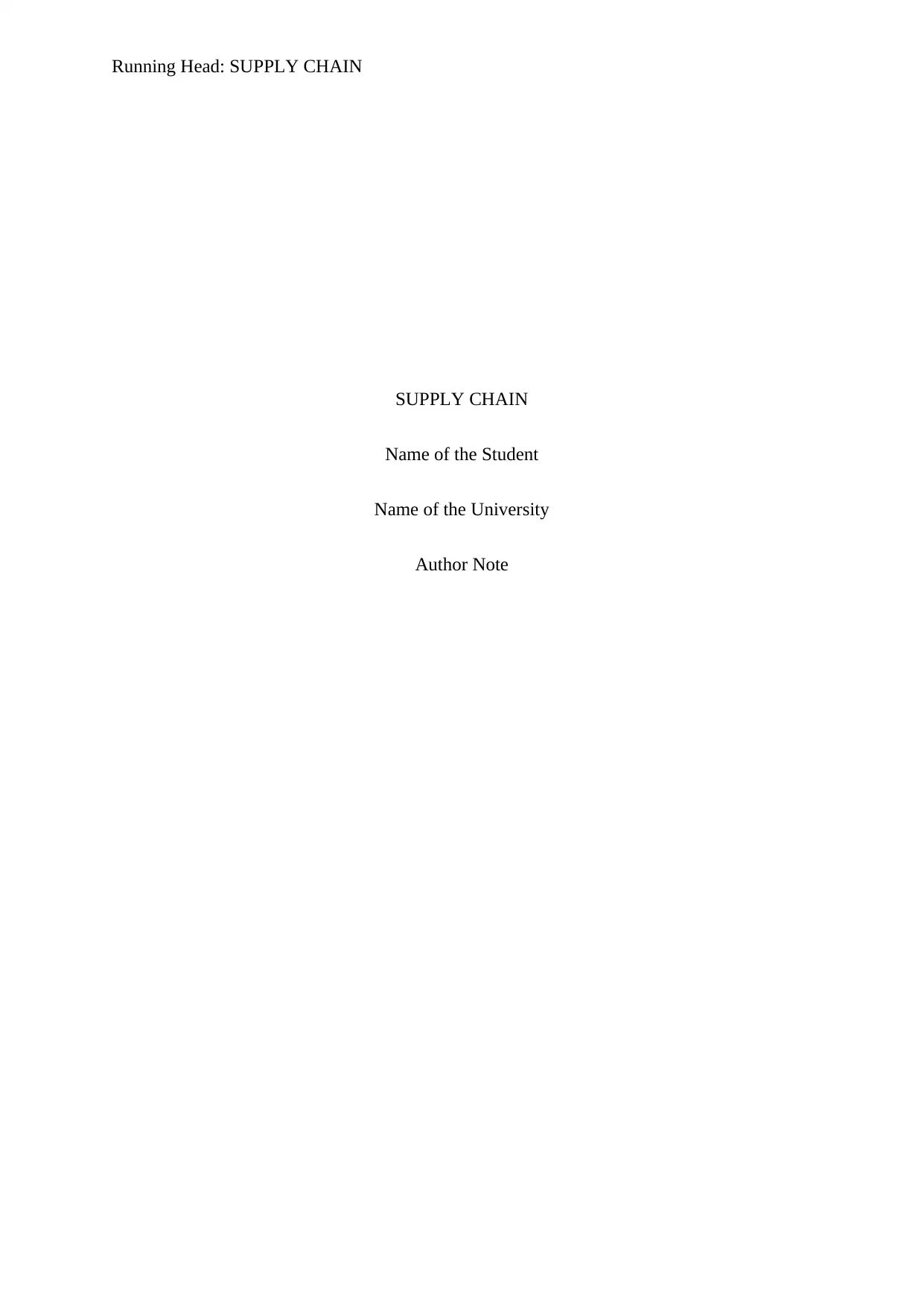
Running Head: SUPPLY CHAIN
SUPPLY CHAIN
Name of the Student
Name of the University
Author Note
SUPPLY CHAIN
Name of the Student
Name of the University
Author Note
Paraphrase This Document
Need a fresh take? Get an instant paraphrase of this document with our AI Paraphraser
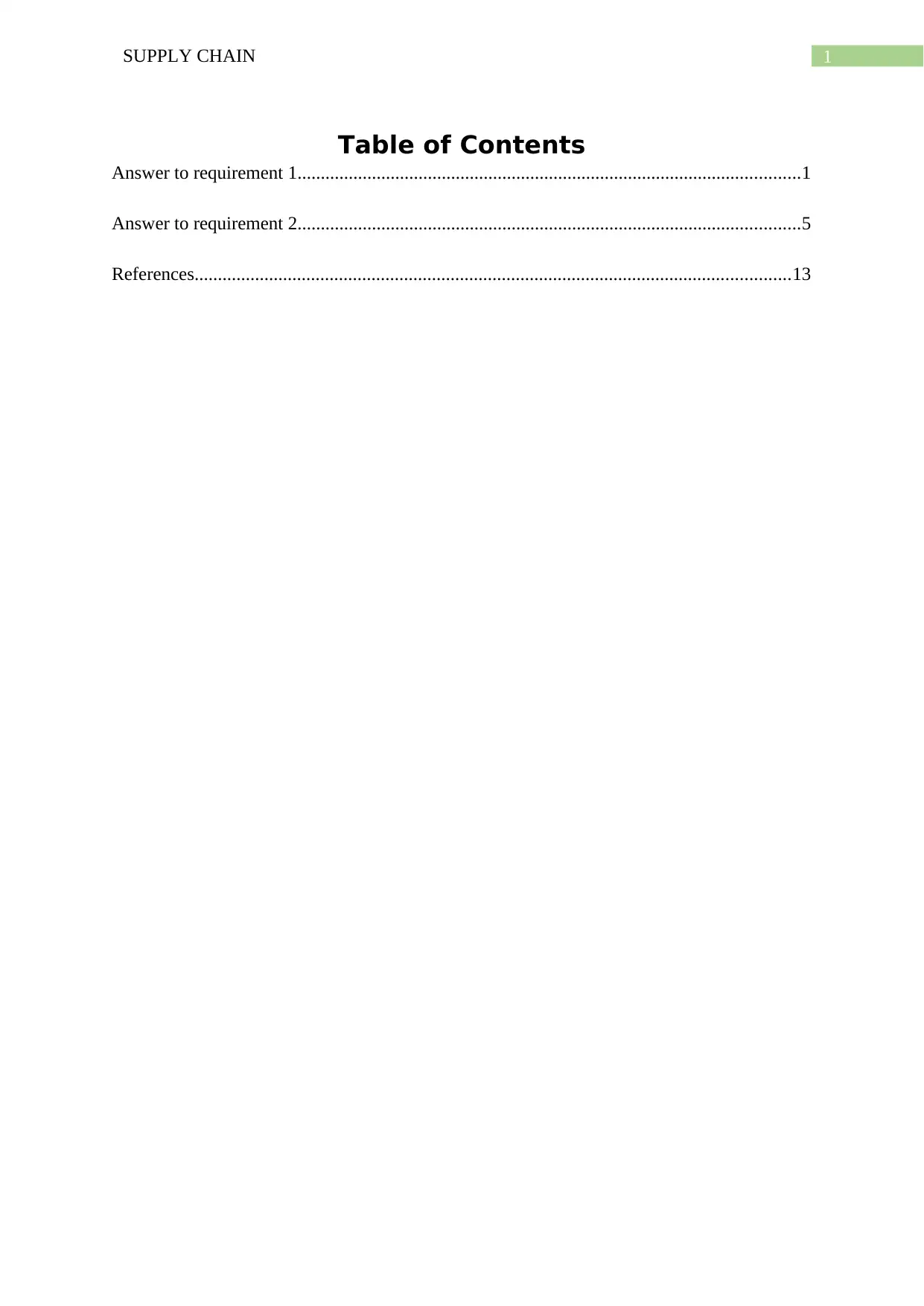
1SUPPLY CHAIN
Table of Contents
Answer to requirement 1............................................................................................................1
Answer to requirement 2............................................................................................................5
References................................................................................................................................13
Table of Contents
Answer to requirement 1............................................................................................................1
Answer to requirement 2............................................................................................................5
References................................................................................................................................13
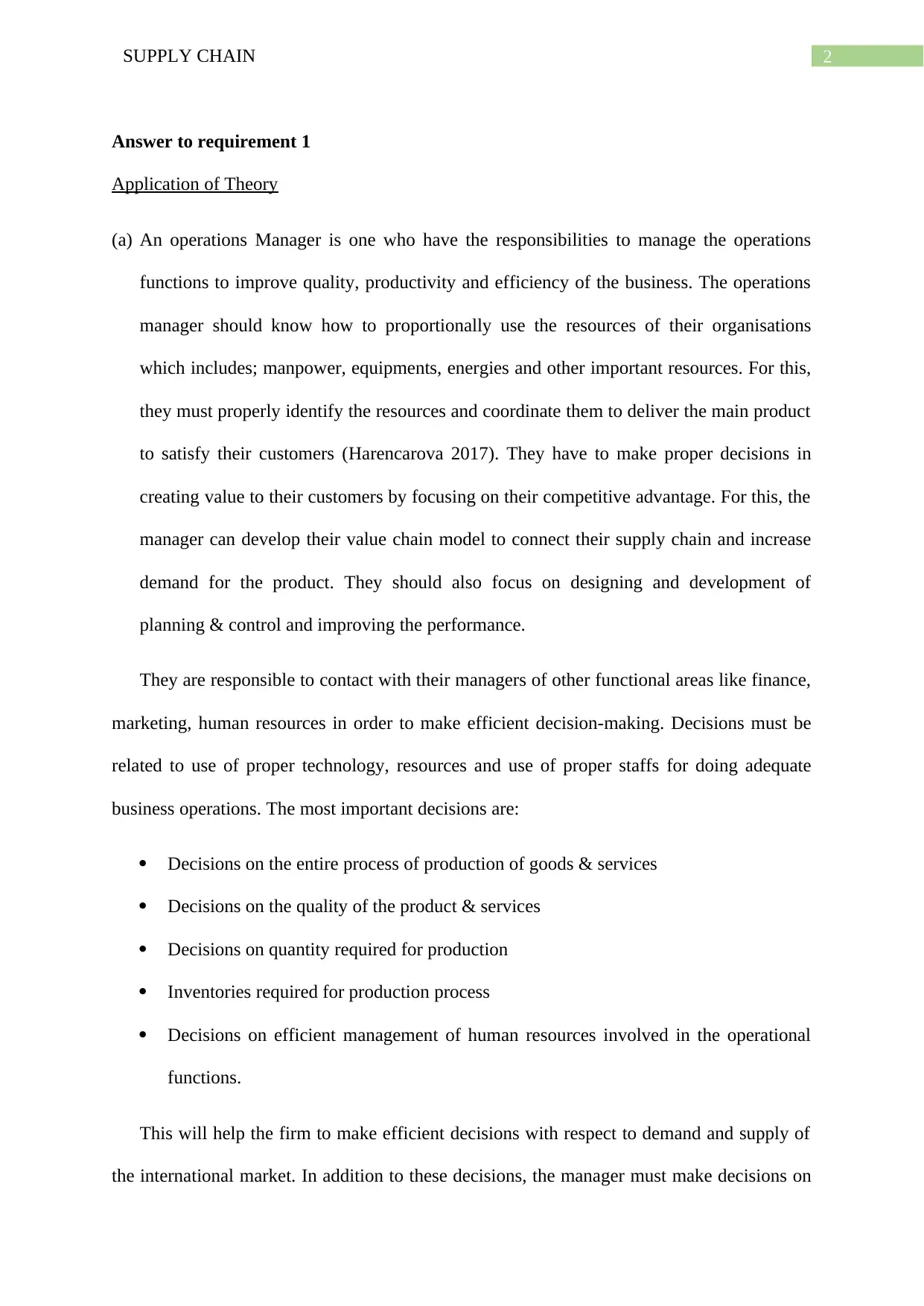
2SUPPLY CHAIN
Answer to requirement 1
Application of Theory
(a) An operations Manager is one who have the responsibilities to manage the operations
functions to improve quality, productivity and efficiency of the business. The operations
manager should know how to proportionally use the resources of their organisations
which includes; manpower, equipments, energies and other important resources. For this,
they must properly identify the resources and coordinate them to deliver the main product
to satisfy their customers (Harencarova 2017). They have to make proper decisions in
creating value to their customers by focusing on their competitive advantage. For this, the
manager can develop their value chain model to connect their supply chain and increase
demand for the product. They should also focus on designing and development of
planning & control and improving the performance.
They are responsible to contact with their managers of other functional areas like finance,
marketing, human resources in order to make efficient decision-making. Decisions must be
related to use of proper technology, resources and use of proper staffs for doing adequate
business operations. The most important decisions are:
Decisions on the entire process of production of goods & services
Decisions on the quality of the product & services
Decisions on quantity required for production
Inventories required for production process
Decisions on efficient management of human resources involved in the operational
functions.
This will help the firm to make efficient decisions with respect to demand and supply of
the international market. In addition to these decisions, the manager must make decisions on
Answer to requirement 1
Application of Theory
(a) An operations Manager is one who have the responsibilities to manage the operations
functions to improve quality, productivity and efficiency of the business. The operations
manager should know how to proportionally use the resources of their organisations
which includes; manpower, equipments, energies and other important resources. For this,
they must properly identify the resources and coordinate them to deliver the main product
to satisfy their customers (Harencarova 2017). They have to make proper decisions in
creating value to their customers by focusing on their competitive advantage. For this, the
manager can develop their value chain model to connect their supply chain and increase
demand for the product. They should also focus on designing and development of
planning & control and improving the performance.
They are responsible to contact with their managers of other functional areas like finance,
marketing, human resources in order to make efficient decision-making. Decisions must be
related to use of proper technology, resources and use of proper staffs for doing adequate
business operations. The most important decisions are:
Decisions on the entire process of production of goods & services
Decisions on the quality of the product & services
Decisions on quantity required for production
Inventories required for production process
Decisions on efficient management of human resources involved in the operational
functions.
This will help the firm to make efficient decisions with respect to demand and supply of
the international market. In addition to these decisions, the manager must make decisions on
⊘ This is a preview!⊘
Do you want full access?
Subscribe today to unlock all pages.

Trusted by 1+ million students worldwide
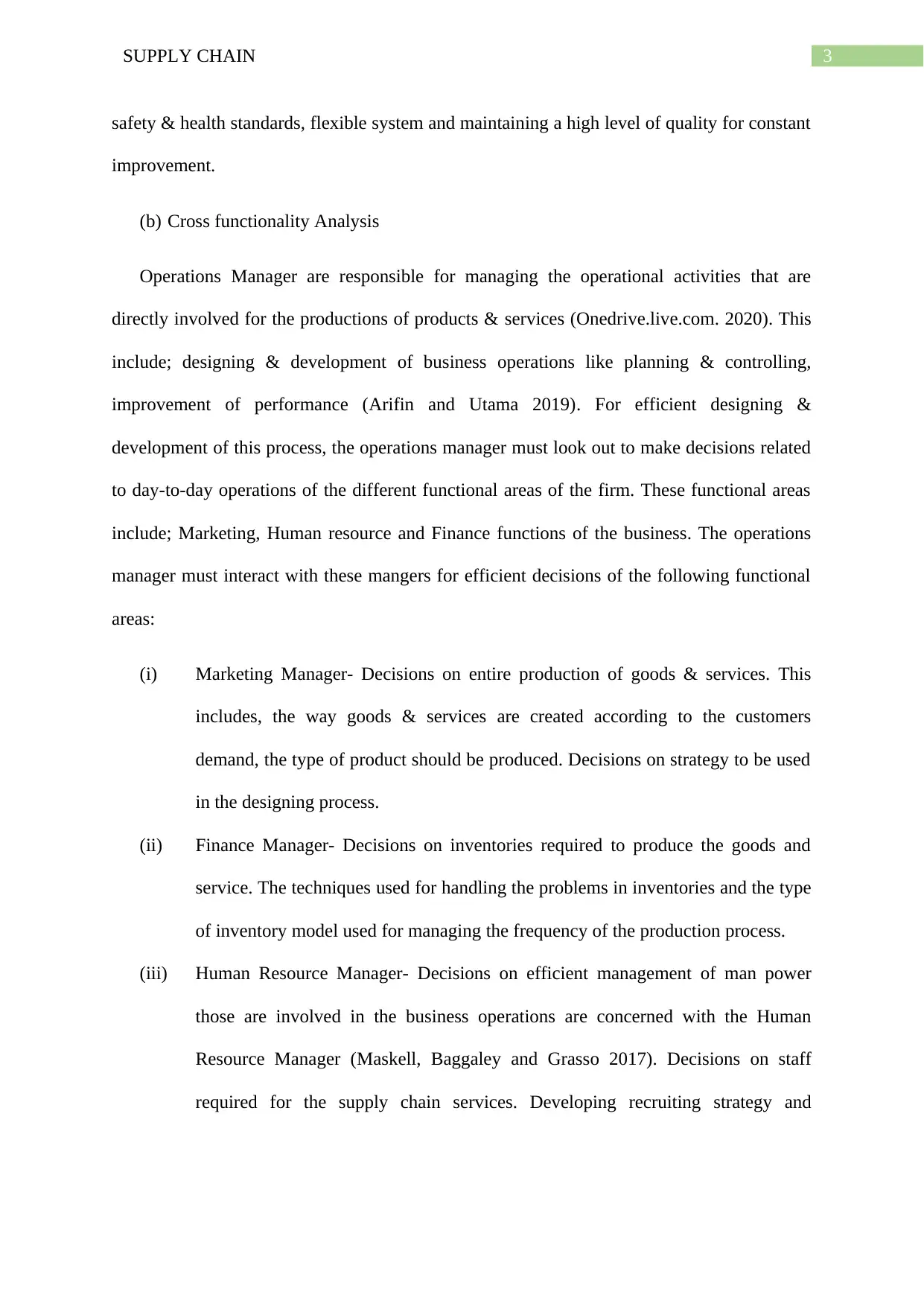
3SUPPLY CHAIN
safety & health standards, flexible system and maintaining a high level of quality for constant
improvement.
(b) Cross functionality Analysis
Operations Manager are responsible for managing the operational activities that are
directly involved for the productions of products & services (Onedrive.live.com. 2020). This
include; designing & development of business operations like planning & controlling,
improvement of performance (Arifin and Utama 2019). For efficient designing &
development of this process, the operations manager must look out to make decisions related
to day-to-day operations of the different functional areas of the firm. These functional areas
include; Marketing, Human resource and Finance functions of the business. The operations
manager must interact with these mangers for efficient decisions of the following functional
areas:
(i) Marketing Manager- Decisions on entire production of goods & services. This
includes, the way goods & services are created according to the customers
demand, the type of product should be produced. Decisions on strategy to be used
in the designing process.
(ii) Finance Manager- Decisions on inventories required to produce the goods and
service. The techniques used for handling the problems in inventories and the type
of inventory model used for managing the frequency of the production process.
(iii) Human Resource Manager- Decisions on efficient management of man power
those are involved in the business operations are concerned with the Human
Resource Manager (Maskell, Baggaley and Grasso 2017). Decisions on staff
required for the supply chain services. Developing recruiting strategy and
safety & health standards, flexible system and maintaining a high level of quality for constant
improvement.
(b) Cross functionality Analysis
Operations Manager are responsible for managing the operational activities that are
directly involved for the productions of products & services (Onedrive.live.com. 2020). This
include; designing & development of business operations like planning & controlling,
improvement of performance (Arifin and Utama 2019). For efficient designing &
development of this process, the operations manager must look out to make decisions related
to day-to-day operations of the different functional areas of the firm. These functional areas
include; Marketing, Human resource and Finance functions of the business. The operations
manager must interact with these mangers for efficient decisions of the following functional
areas:
(i) Marketing Manager- Decisions on entire production of goods & services. This
includes, the way goods & services are created according to the customers
demand, the type of product should be produced. Decisions on strategy to be used
in the designing process.
(ii) Finance Manager- Decisions on inventories required to produce the goods and
service. The techniques used for handling the problems in inventories and the type
of inventory model used for managing the frequency of the production process.
(iii) Human Resource Manager- Decisions on efficient management of man power
those are involved in the business operations are concerned with the Human
Resource Manager (Maskell, Baggaley and Grasso 2017). Decisions on staff
required for the supply chain services. Developing recruiting strategy and
Paraphrase This Document
Need a fresh take? Get an instant paraphrase of this document with our AI Paraphraser

4SUPPLY CHAIN
rewarding the workforce for creating a labour relations and collaborating them
with the supply chain process.
(c) Service Process is the way in which the firm delivers an adequate customer receives
service process. The stores can use transformation model of operations to deliver their
goods to their customers. In this model, the input resources can transform the resource
into the required output.
Figure 1: Transformation Model
This is also known as input-transformation-output model.
Input- It may include materials like retail operations, and store materials; Information
like sell information, accountants and transforming resources like technologies &
process and the people/labour involved in the previous stores in the operations.
Transformation process- These are the group of activities that transfers these inputs
into output (Wang et al. 2018). The activities include change in the location of the
stores, storing the store materials, information related to market data, changing the
physical characteristics of stores like use of easy shopping techniques.
rewarding the workforce for creating a labour relations and collaborating them
with the supply chain process.
(c) Service Process is the way in which the firm delivers an adequate customer receives
service process. The stores can use transformation model of operations to deliver their
goods to their customers. In this model, the input resources can transform the resource
into the required output.
Figure 1: Transformation Model
This is also known as input-transformation-output model.
Input- It may include materials like retail operations, and store materials; Information
like sell information, accountants and transforming resources like technologies &
process and the people/labour involved in the previous stores in the operations.
Transformation process- These are the group of activities that transfers these inputs
into output (Wang et al. 2018). The activities include change in the location of the
stores, storing the store materials, information related to market data, changing the
physical characteristics of stores like use of easy shopping techniques.

5SUPPLY CHAIN
Output- Output includes the goods or service of the service. This also includes
delivering the product or service to the customers.
Feedback- Feedback from the customers is to be used in the operation system. The
stores can employ staff in the help desk for receiving information from their
customers. This will help the store to change their process according to customer
demands.
Plant layout – The store can use process layout or functional layout for doing business in
the suburban areas. In this the operations of convenience stores are arranged in the common
process of a2z. Work will travel between them (Naik and Kallurkar 2016). This layout will
help the store to trade easily with flexibility in the system and reducing the cost. The
operators can also do work by using different innovative processes.
(d) While expanding the business, the operations manager will face the following
considerations:
Operations manager will face difficulty in understanding the nature of the
operations. The strategies used in the planning and control practices for the new
operations.
Managers will face difficulty in managing the demand of the operations in the
new stores. Hence, mangers will face challenges in managing the capacity and
demand. In order to make proper decisions on the risk involved to meet the
demand, risk on investing the resources to meet the needs, properly measuring the
fluctuations of demand, establishment of adequate strategy are the tough decisions
that an operations manager would face.
Exact capacity of staffs, equipment, level of materials and information required in
the process.
Output- Output includes the goods or service of the service. This also includes
delivering the product or service to the customers.
Feedback- Feedback from the customers is to be used in the operation system. The
stores can employ staff in the help desk for receiving information from their
customers. This will help the store to change their process according to customer
demands.
Plant layout – The store can use process layout or functional layout for doing business in
the suburban areas. In this the operations of convenience stores are arranged in the common
process of a2z. Work will travel between them (Naik and Kallurkar 2016). This layout will
help the store to trade easily with flexibility in the system and reducing the cost. The
operators can also do work by using different innovative processes.
(d) While expanding the business, the operations manager will face the following
considerations:
Operations manager will face difficulty in understanding the nature of the
operations. The strategies used in the planning and control practices for the new
operations.
Managers will face difficulty in managing the demand of the operations in the
new stores. Hence, mangers will face challenges in managing the capacity and
demand. In order to make proper decisions on the risk involved to meet the
demand, risk on investing the resources to meet the needs, properly measuring the
fluctuations of demand, establishment of adequate strategy are the tough decisions
that an operations manager would face.
Exact capacity of staffs, equipment, level of materials and information required in
the process.
⊘ This is a preview!⊘
Do you want full access?
Subscribe today to unlock all pages.

Trusted by 1+ million students worldwide

6SUPPLY CHAIN
Forecasting the exact demand according to the changing behaviour of the
customers will be a very difficult task for the operations manager. Adequately
managing the demand like good servicing of customers in the stores to satisfy the
customer experience (Roehrich, Hoejmose and Overland 2017). Therefore,
forecasting of exact information and accordingly allocating the resources in
advance in an efficient manner will be quiet challenging for the operational
manager.
Operating at the same level of capacity and meeting the changing level of
customer demand is also challenging for the manager (Li, Cui and Lu 2018). This
requires minimising the operating costs of the operations.
Adequate scheduling of the day-to-day operations process to manage the
customer’s order is also challenging for the operations manager (Shapiro and
Hanouna 2019). Scheduling also includes, planning for the exact quantity of
output and sequencing the tasks.
Answer to requirement 2
2.1 Definitions
i) Lean- Lean in supply chain management is a type of strategy that is used to reduce
the cost & time of the process involved in the supply chain. It helps in reducing
the waste of the operations. It focus on making right product to the customers at
the right time & location (Alefari, Salonitis and Xu 2017). Lean supply chain
process includes all the process of product life cycle stage, starting with the
product design stage to delivering the product to the end customers. Lean
paradigm is better in case of high volume of product with low varieties.
ii) Agile- This focus on rapid responses to the market changes. It have the ability to
quickly respond the changes and reduce the costs in terms of volume & variety. It
Forecasting the exact demand according to the changing behaviour of the
customers will be a very difficult task for the operations manager. Adequately
managing the demand like good servicing of customers in the stores to satisfy the
customer experience (Roehrich, Hoejmose and Overland 2017). Therefore,
forecasting of exact information and accordingly allocating the resources in
advance in an efficient manner will be quiet challenging for the operational
manager.
Operating at the same level of capacity and meeting the changing level of
customer demand is also challenging for the manager (Li, Cui and Lu 2018). This
requires minimising the operating costs of the operations.
Adequate scheduling of the day-to-day operations process to manage the
customer’s order is also challenging for the operations manager (Shapiro and
Hanouna 2019). Scheduling also includes, planning for the exact quantity of
output and sequencing the tasks.
Answer to requirement 2
2.1 Definitions
i) Lean- Lean in supply chain management is a type of strategy that is used to reduce
the cost & time of the process involved in the supply chain. It helps in reducing
the waste of the operations. It focus on making right product to the customers at
the right time & location (Alefari, Salonitis and Xu 2017). Lean supply chain
process includes all the process of product life cycle stage, starting with the
product design stage to delivering the product to the end customers. Lean
paradigm is better in case of high volume of product with low varieties.
ii) Agile- This focus on rapid responses to the market changes. It have the ability to
quickly respond the changes and reduce the costs in terms of volume & variety. It
Paraphrase This Document
Need a fresh take? Get an instant paraphrase of this document with our AI Paraphraser
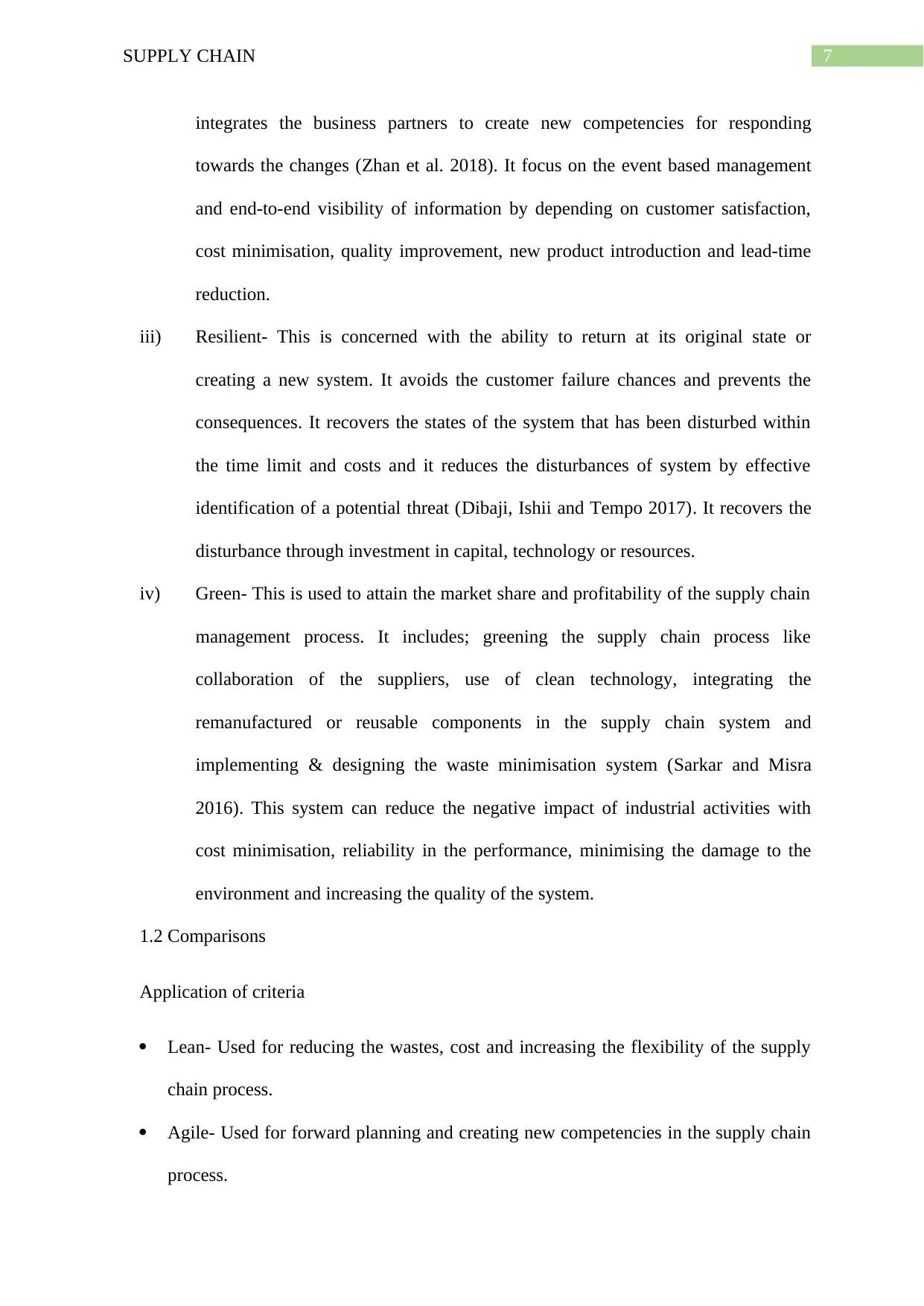
7SUPPLY CHAIN
integrates the business partners to create new competencies for responding
towards the changes (Zhan et al. 2018). It focus on the event based management
and end-to-end visibility of information by depending on customer satisfaction,
cost minimisation, quality improvement, new product introduction and lead-time
reduction.
iii) Resilient- This is concerned with the ability to return at its original state or
creating a new system. It avoids the customer failure chances and prevents the
consequences. It recovers the states of the system that has been disturbed within
the time limit and costs and it reduces the disturbances of system by effective
identification of a potential threat (Dibaji, Ishii and Tempo 2017). It recovers the
disturbance through investment in capital, technology or resources.
iv) Green- This is used to attain the market share and profitability of the supply chain
management process. It includes; greening the supply chain process like
collaboration of the suppliers, use of clean technology, integrating the
remanufactured or reusable components in the supply chain system and
implementing & designing the waste minimisation system (Sarkar and Misra
2016). This system can reduce the negative impact of industrial activities with
cost minimisation, reliability in the performance, minimising the damage to the
environment and increasing the quality of the system.
1.2 Comparisons
Application of criteria
Lean- Used for reducing the wastes, cost and increasing the flexibility of the supply
chain process.
Agile- Used for forward planning and creating new competencies in the supply chain
process.
integrates the business partners to create new competencies for responding
towards the changes (Zhan et al. 2018). It focus on the event based management
and end-to-end visibility of information by depending on customer satisfaction,
cost minimisation, quality improvement, new product introduction and lead-time
reduction.
iii) Resilient- This is concerned with the ability to return at its original state or
creating a new system. It avoids the customer failure chances and prevents the
consequences. It recovers the states of the system that has been disturbed within
the time limit and costs and it reduces the disturbances of system by effective
identification of a potential threat (Dibaji, Ishii and Tempo 2017). It recovers the
disturbance through investment in capital, technology or resources.
iv) Green- This is used to attain the market share and profitability of the supply chain
management process. It includes; greening the supply chain process like
collaboration of the suppliers, use of clean technology, integrating the
remanufactured or reusable components in the supply chain system and
implementing & designing the waste minimisation system (Sarkar and Misra
2016). This system can reduce the negative impact of industrial activities with
cost minimisation, reliability in the performance, minimising the damage to the
environment and increasing the quality of the system.
1.2 Comparisons
Application of criteria
Lean- Used for reducing the wastes, cost and increasing the flexibility of the supply
chain process.
Agile- Used for forward planning and creating new competencies in the supply chain
process.
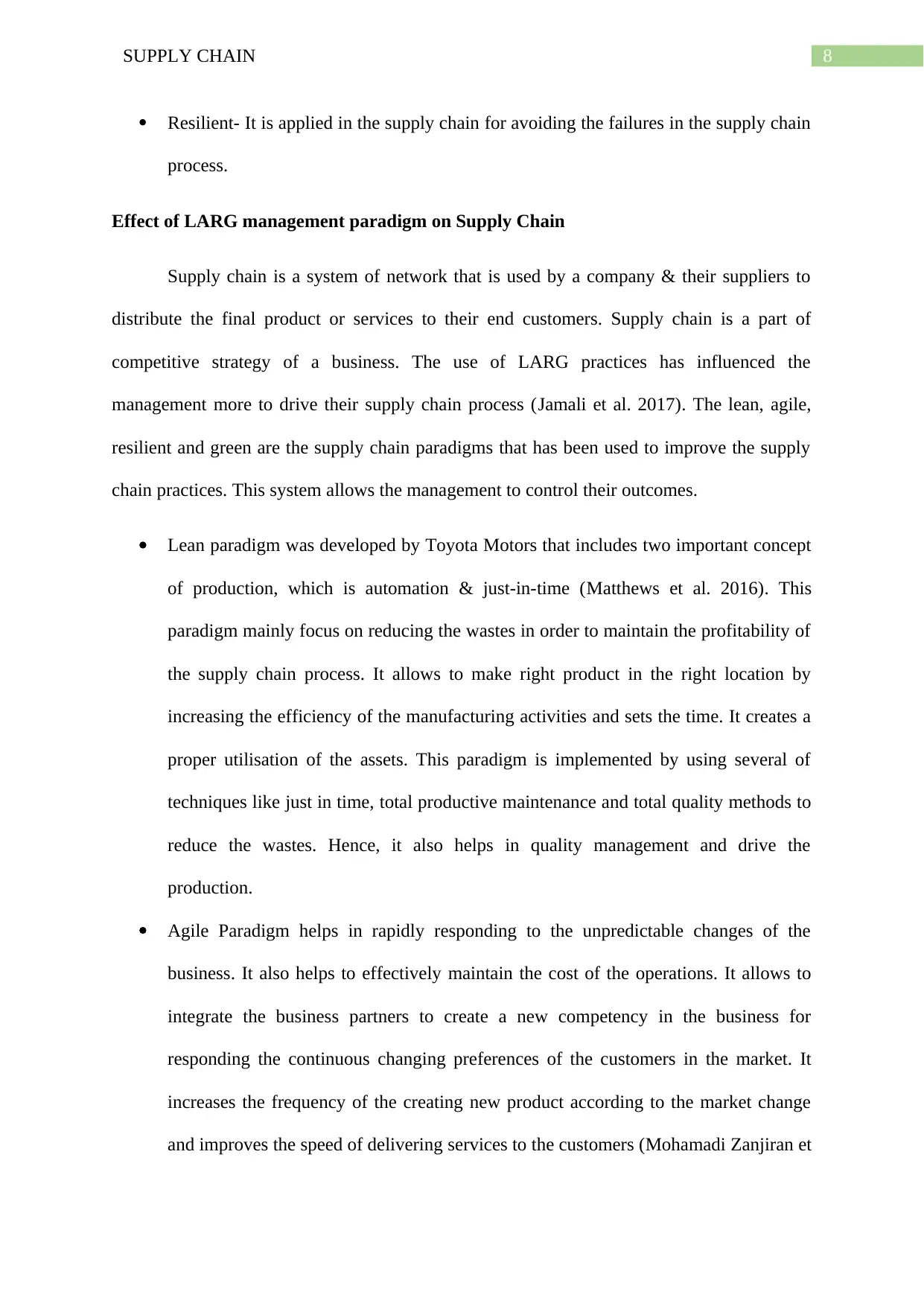
8SUPPLY CHAIN
Resilient- It is applied in the supply chain for avoiding the failures in the supply chain
process.
Effect of LARG management paradigm on Supply Chain
Supply chain is a system of network that is used by a company & their suppliers to
distribute the final product or services to their end customers. Supply chain is a part of
competitive strategy of a business. The use of LARG practices has influenced the
management more to drive their supply chain process (Jamali et al. 2017). The lean, agile,
resilient and green are the supply chain paradigms that has been used to improve the supply
chain practices. This system allows the management to control their outcomes.
Lean paradigm was developed by Toyota Motors that includes two important concept
of production, which is automation & just-in-time (Matthews et al. 2016). This
paradigm mainly focus on reducing the wastes in order to maintain the profitability of
the supply chain process. It allows to make right product in the right location by
increasing the efficiency of the manufacturing activities and sets the time. It creates a
proper utilisation of the assets. This paradigm is implemented by using several of
techniques like just in time, total productive maintenance and total quality methods to
reduce the wastes. Hence, it also helps in quality management and drive the
production.
Agile Paradigm helps in rapidly responding to the unpredictable changes of the
business. It also helps to effectively maintain the cost of the operations. It allows to
integrate the business partners to create a new competency in the business for
responding the continuous changing preferences of the customers in the market. It
increases the frequency of the creating new product according to the market change
and improves the speed of delivering services to the customers (Mohamadi Zanjiran et
Resilient- It is applied in the supply chain for avoiding the failures in the supply chain
process.
Effect of LARG management paradigm on Supply Chain
Supply chain is a system of network that is used by a company & their suppliers to
distribute the final product or services to their end customers. Supply chain is a part of
competitive strategy of a business. The use of LARG practices has influenced the
management more to drive their supply chain process (Jamali et al. 2017). The lean, agile,
resilient and green are the supply chain paradigms that has been used to improve the supply
chain practices. This system allows the management to control their outcomes.
Lean paradigm was developed by Toyota Motors that includes two important concept
of production, which is automation & just-in-time (Matthews et al. 2016). This
paradigm mainly focus on reducing the wastes in order to maintain the profitability of
the supply chain process. It allows to make right product in the right location by
increasing the efficiency of the manufacturing activities and sets the time. It creates a
proper utilisation of the assets. This paradigm is implemented by using several of
techniques like just in time, total productive maintenance and total quality methods to
reduce the wastes. Hence, it also helps in quality management and drive the
production.
Agile Paradigm helps in rapidly responding to the unpredictable changes of the
business. It also helps to effectively maintain the cost of the operations. It allows to
integrate the business partners to create a new competency in the business for
responding the continuous changing preferences of the customers in the market. It
increases the frequency of the creating new product according to the market change
and improves the speed of delivering services to the customers (Mohamadi Zanjiran et
⊘ This is a preview!⊘
Do you want full access?
Subscribe today to unlock all pages.

Trusted by 1+ million students worldwide
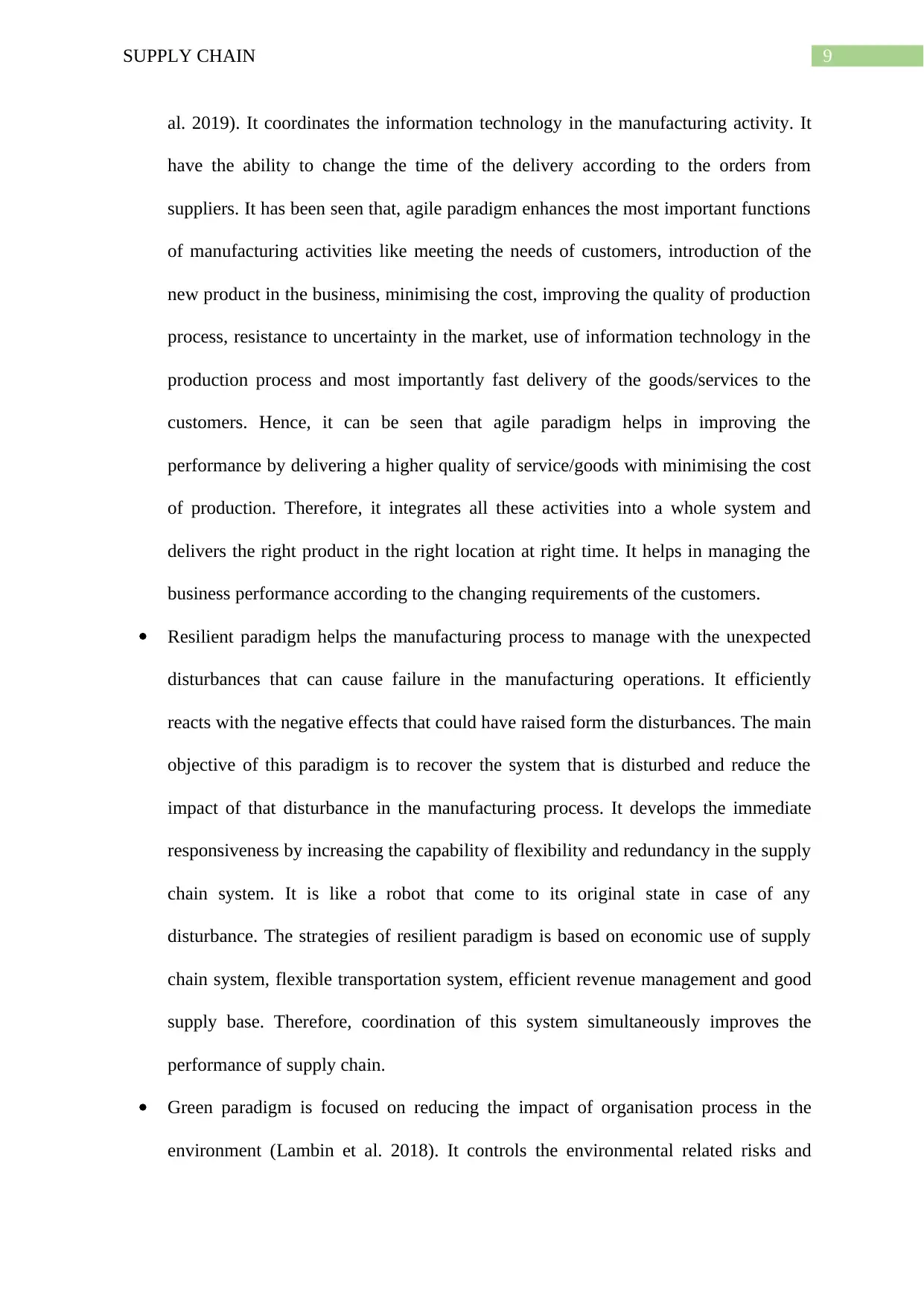
9SUPPLY CHAIN
al. 2019). It coordinates the information technology in the manufacturing activity. It
have the ability to change the time of the delivery according to the orders from
suppliers. It has been seen that, agile paradigm enhances the most important functions
of manufacturing activities like meeting the needs of customers, introduction of the
new product in the business, minimising the cost, improving the quality of production
process, resistance to uncertainty in the market, use of information technology in the
production process and most importantly fast delivery of the goods/services to the
customers. Hence, it can be seen that agile paradigm helps in improving the
performance by delivering a higher quality of service/goods with minimising the cost
of production. Therefore, it integrates all these activities into a whole system and
delivers the right product in the right location at right time. It helps in managing the
business performance according to the changing requirements of the customers.
Resilient paradigm helps the manufacturing process to manage with the unexpected
disturbances that can cause failure in the manufacturing operations. It efficiently
reacts with the negative effects that could have raised form the disturbances. The main
objective of this paradigm is to recover the system that is disturbed and reduce the
impact of that disturbance in the manufacturing process. It develops the immediate
responsiveness by increasing the capability of flexibility and redundancy in the supply
chain system. It is like a robot that come to its original state in case of any
disturbance. The strategies of resilient paradigm is based on economic use of supply
chain system, flexible transportation system, efficient revenue management and good
supply base. Therefore, coordination of this system simultaneously improves the
performance of supply chain.
Green paradigm is focused on reducing the impact of organisation process in the
environment (Lambin et al. 2018). It controls the environmental related risks and
al. 2019). It coordinates the information technology in the manufacturing activity. It
have the ability to change the time of the delivery according to the orders from
suppliers. It has been seen that, agile paradigm enhances the most important functions
of manufacturing activities like meeting the needs of customers, introduction of the
new product in the business, minimising the cost, improving the quality of production
process, resistance to uncertainty in the market, use of information technology in the
production process and most importantly fast delivery of the goods/services to the
customers. Hence, it can be seen that agile paradigm helps in improving the
performance by delivering a higher quality of service/goods with minimising the cost
of production. Therefore, it integrates all these activities into a whole system and
delivers the right product in the right location at right time. It helps in managing the
business performance according to the changing requirements of the customers.
Resilient paradigm helps the manufacturing process to manage with the unexpected
disturbances that can cause failure in the manufacturing operations. It efficiently
reacts with the negative effects that could have raised form the disturbances. The main
objective of this paradigm is to recover the system that is disturbed and reduce the
impact of that disturbance in the manufacturing process. It develops the immediate
responsiveness by increasing the capability of flexibility and redundancy in the supply
chain system. It is like a robot that come to its original state in case of any
disturbance. The strategies of resilient paradigm is based on economic use of supply
chain system, flexible transportation system, efficient revenue management and good
supply base. Therefore, coordination of this system simultaneously improves the
performance of supply chain.
Green paradigm is focused on reducing the impact of organisation process in the
environment (Lambin et al. 2018). It controls the environmental related risks and
Paraphrase This Document
Need a fresh take? Get an instant paraphrase of this document with our AI Paraphraser
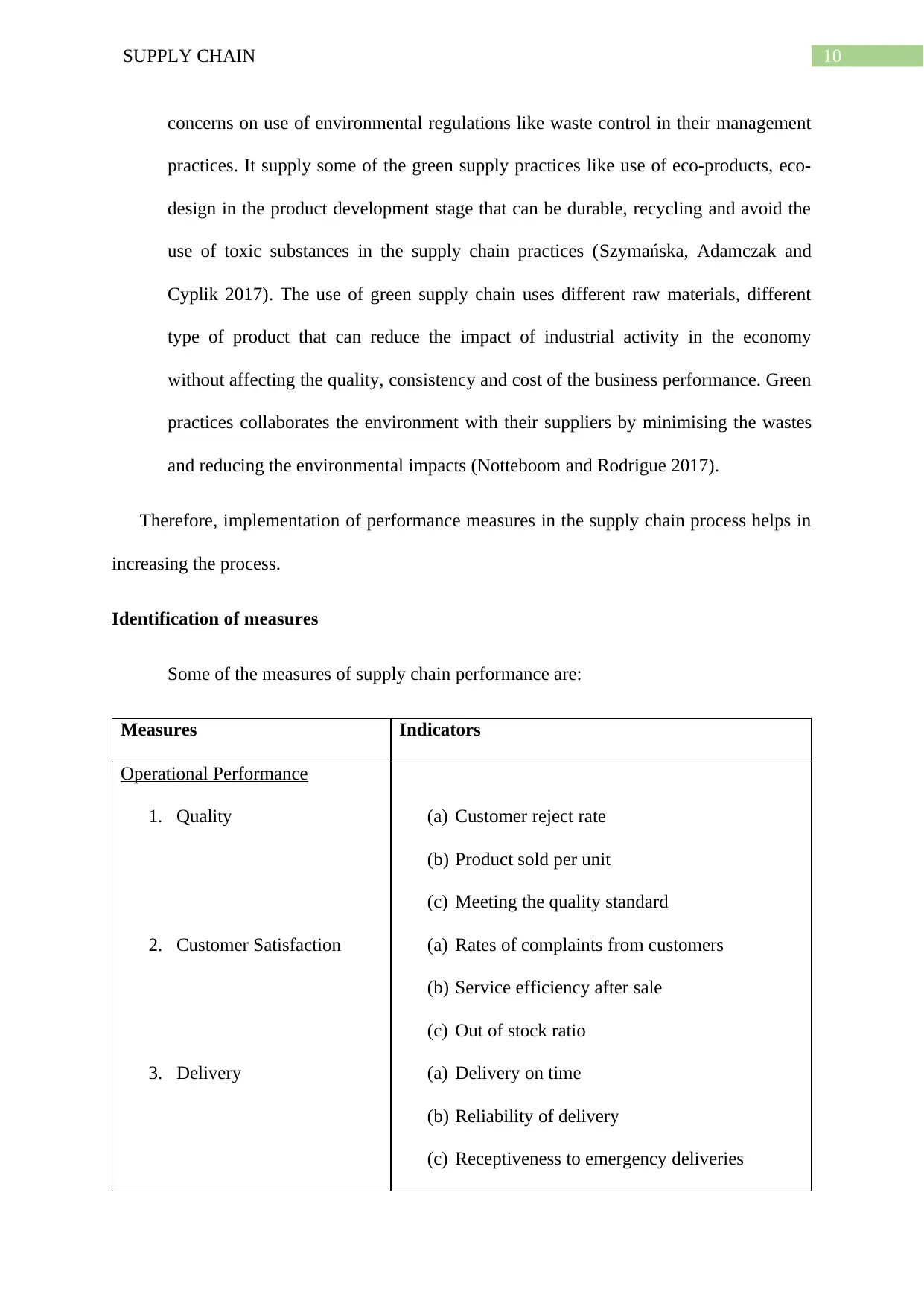
10SUPPLY CHAIN
concerns on use of environmental regulations like waste control in their management
practices. It supply some of the green supply practices like use of eco-products, eco-
design in the product development stage that can be durable, recycling and avoid the
use of toxic substances in the supply chain practices (Szymańska, Adamczak and
Cyplik 2017). The use of green supply chain uses different raw materials, different
type of product that can reduce the impact of industrial activity in the economy
without affecting the quality, consistency and cost of the business performance. Green
practices collaborates the environment with their suppliers by minimising the wastes
and reducing the environmental impacts (Notteboom and Rodrigue 2017).
Therefore, implementation of performance measures in the supply chain process helps in
increasing the process.
Identification of measures
Some of the measures of supply chain performance are:
Measures Indicators
Operational Performance
1. Quality
2. Customer Satisfaction
3. Delivery
(a) Customer reject rate
(b) Product sold per unit
(c) Meeting the quality standard
(a) Rates of complaints from customers
(b) Service efficiency after sale
(c) Out of stock ratio
(a) Delivery on time
(b) Reliability of delivery
(c) Receptiveness to emergency deliveries
concerns on use of environmental regulations like waste control in their management
practices. It supply some of the green supply practices like use of eco-products, eco-
design in the product development stage that can be durable, recycling and avoid the
use of toxic substances in the supply chain practices (Szymańska, Adamczak and
Cyplik 2017). The use of green supply chain uses different raw materials, different
type of product that can reduce the impact of industrial activity in the economy
without affecting the quality, consistency and cost of the business performance. Green
practices collaborates the environment with their suppliers by minimising the wastes
and reducing the environmental impacts (Notteboom and Rodrigue 2017).
Therefore, implementation of performance measures in the supply chain process helps in
increasing the process.
Identification of measures
Some of the measures of supply chain performance are:
Measures Indicators
Operational Performance
1. Quality
2. Customer Satisfaction
3. Delivery
(a) Customer reject rate
(b) Product sold per unit
(c) Meeting the quality standard
(a) Rates of complaints from customers
(b) Service efficiency after sale
(c) Out of stock ratio
(a) Delivery on time
(b) Reliability of delivery
(c) Receptiveness to emergency deliveries
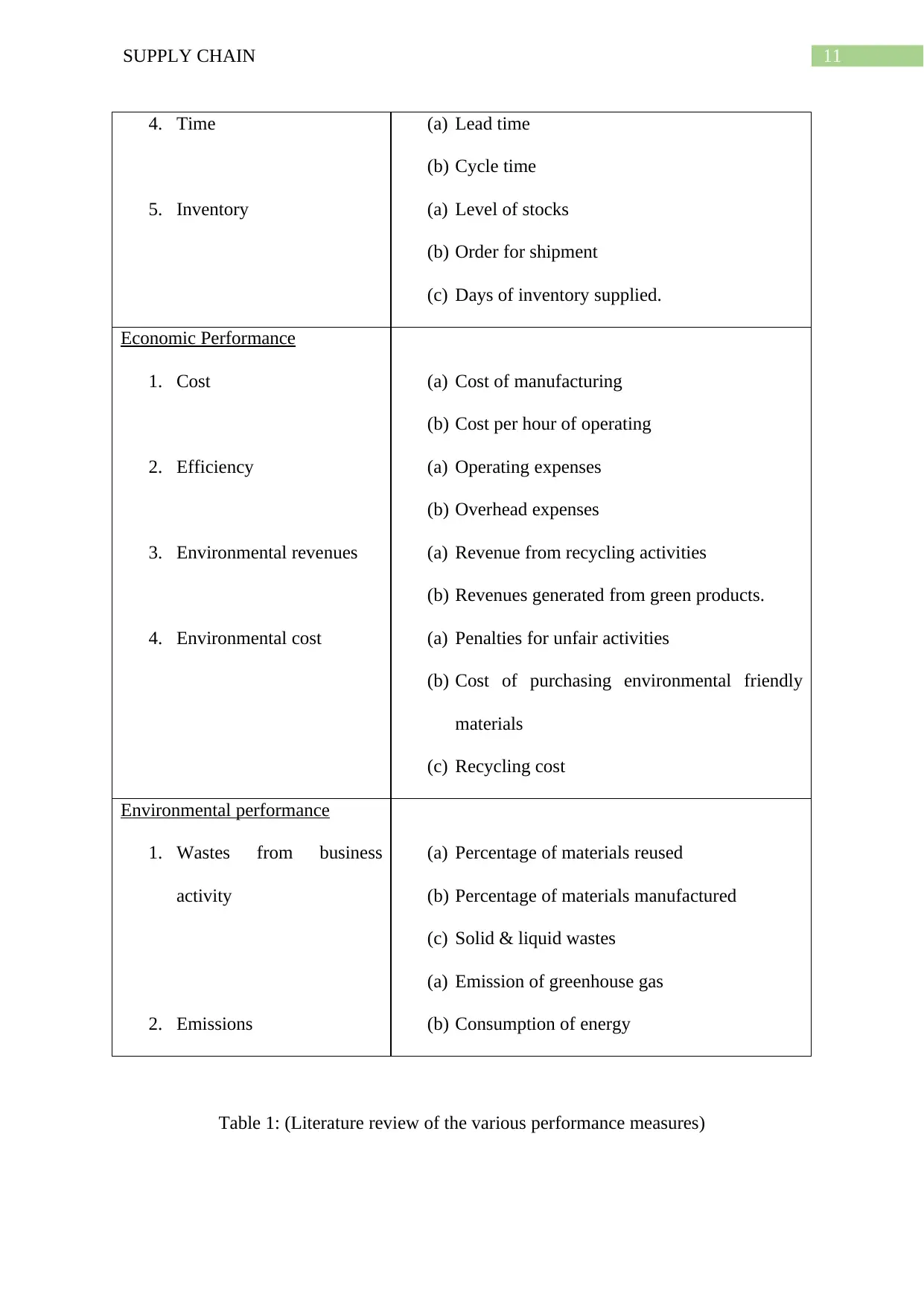
11SUPPLY CHAIN
4. Time
5. Inventory
(a) Lead time
(b) Cycle time
(a) Level of stocks
(b) Order for shipment
(c) Days of inventory supplied.
Economic Performance
1. Cost
2. Efficiency
3. Environmental revenues
4. Environmental cost
(a) Cost of manufacturing
(b) Cost per hour of operating
(a) Operating expenses
(b) Overhead expenses
(a) Revenue from recycling activities
(b) Revenues generated from green products.
(a) Penalties for unfair activities
(b) Cost of purchasing environmental friendly
materials
(c) Recycling cost
Environmental performance
1. Wastes from business
activity
2. Emissions
(a) Percentage of materials reused
(b) Percentage of materials manufactured
(c) Solid & liquid wastes
(a) Emission of greenhouse gas
(b) Consumption of energy
Table 1: (Literature review of the various performance measures)
4. Time
5. Inventory
(a) Lead time
(b) Cycle time
(a) Level of stocks
(b) Order for shipment
(c) Days of inventory supplied.
Economic Performance
1. Cost
2. Efficiency
3. Environmental revenues
4. Environmental cost
(a) Cost of manufacturing
(b) Cost per hour of operating
(a) Operating expenses
(b) Overhead expenses
(a) Revenue from recycling activities
(b) Revenues generated from green products.
(a) Penalties for unfair activities
(b) Cost of purchasing environmental friendly
materials
(c) Recycling cost
Environmental performance
1. Wastes from business
activity
2. Emissions
(a) Percentage of materials reused
(b) Percentage of materials manufactured
(c) Solid & liquid wastes
(a) Emission of greenhouse gas
(b) Consumption of energy
Table 1: (Literature review of the various performance measures)
⊘ This is a preview!⊘
Do you want full access?
Subscribe today to unlock all pages.

Trusted by 1+ million students worldwide
1 out of 17
Related Documents
Your All-in-One AI-Powered Toolkit for Academic Success.
+13062052269
info@desklib.com
Available 24*7 on WhatsApp / Email
![[object Object]](/_next/static/media/star-bottom.7253800d.svg)
Unlock your academic potential
Copyright © 2020–2025 A2Z Services. All Rights Reserved. Developed and managed by ZUCOL.



